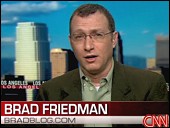
 IN TODAY'S AUDIO REPORT: Bush smacked down on smog; Texans told to conserve; Naked & recycled .... PLUS: The 50th Anniversary of the nation's first --- and worst --- nuclear accident ... All that and more in today's Green News Report!
IN TODAY'S AUDIO REPORT: Bush smacked down on smog; Texans told to conserve; Naked & recycled .... PLUS: The 50th Anniversary of the nation's first --- and worst --- nuclear accident ... All that and more in today's Green News Report!
Got comments, tips, love letters, hate mail, melted radioactive fuel rods? Drop us a line at GreenNews@BradBlog.com or right here at the comments link below. All GNRs are always archived at GreenNews.BradBlog.com.
IN 'GREEN NEWS EXTRA' (links below): Obama warns of return of swine flu in the fall --- and how to be prepared!; How does your grocery store rate on sustainable seafood?... PLUS: China seeks worldwide dominance in clean energy...
Info/links on those stories and all the ones we talked about on today's episode follow below...
- Power plant slap-down in federal court (LA Times):
Under the Clean Air Act, new polluters can build in areas where the air has yet to meet federal health standards, but only if they purchase credits from other plants that close down, thus reducing pollution. But the Bush administration expanded those rules, allowing new polluters to buy credits from plants that were shuttered decades ago.
...
The Los Angeles air basin is one of the dirtiest regions in the nation. Power plants are a leading source of the pollutants that make up ozone, a precursor to smog, which is linked to premature deaths and respiratory disease. They are also major sources of soot and particles that are linked to cancer and heart disease. - Court Overturns Bush-Era Smog Rule(NY Times)
- L.A.'s Coal Ban Leads to Another Abandoned Power Plant (Greenbiz.com)
- Naked Juice, Earthbound Farms Switch to Recycled Packaging (Greenbiz.com)
- Texas braces for another record electric-use day (Reuters)
- Record energy use expected again Thursday --- but not in Austin (KVUE Austin)
- City of Austin Guidelines to conserve electricity:
Customers can help manage peak demand by reducing energy use between 3:00 p.m. and 7:00 p.m. The key is to reduce heat in the home, which in turn reduces air conditioning needs. Air conditioning is about 70 percent of the average summer electric bill. Tips for reducing energy use and air conditioning:* Turn off all lights and electronic equipment not needed
* Close blinds and drapes to keep direct sunlight from shining into rooms
* Use a microwave rather than the stove/oven as possible
* Dry clothes at night or during mornings
* Use fans, which can make you feel several degrees cooler
* Set your thermostat a few degrees higher than settings you normally use - Heat, Water, Power: weak climate bill precedes nuke-cost announcement (San Antonio Current):
Still, while nuclear costs continue to track a course into our warming atmosphere, critics of the plan are quick to point out solar is the only significant power source seeing its costs drop, rapidly.Then there is the issue of water.
If San Antonio ever performs an honest cost-benefit analysis of our power options, we may find that carbon isn’t the only risk to be avoided.
Just think: STP expansion would evaporate 37,000 acre-feet of water per year — 12 billion gallons. It would rinse-and-release far more than that.
- Solar Push in Texas Fails (Green Inc.)
- Marking the 50th anniversary of the first U.S. nuclear meltdown (LA Times)
- '59 nuclear reactor accident remains vivid for former Santa Susana Field Laboratory worker (Ventura County Star):
Something was wrong. John Pace saw it in the men’s faces, heard the anxiety in their voices and felt the nervous excitement in the nuclear reactor control room at the sprawling Santa Susana Field Laboratory. “I knew something had happened,” said Pace, then a 20-year-old Moorpark resident working as a reactor trainee at the Sodium Reactor Experiment in the hills of eastern Ventura County.At 6:25 p.m. on July 13, 1959, the experimental reactor’s power went out of control, forcing a manual emergency shutdown after an automatic shutdown failed to kick in. It was the beginning of a partial meltdown, a rarity in U.S. history.
For 13 days, officials turned the damaged reactor on and off despite high radiation levels, more emergency shutdowns, and the release of radioactive gases into the air. In some cases, the readings exceeded monitoring instruments’ capacity to measure them...

'GREEN NEWS EXTRA': More green news not covered in today's audio report... See below!
- Obama Warns of Return of Swine Flu in the Fall (NY Times)
- University of Minnesota: Personal Pandemic Preparedness Resource List
- Flu strains circulate for years before becoming a pandemic (USA Today)
- Greenpeace scores groceries for seafood sustainability (WABC-TV)
- Green Power Takes Root in the Chinese Desert (NYT):
This oasis town deep in the Gobi Desert along the famed Silk Road and the surrounding wilderness of beige sand dunes and vast gravel wastelands has become a center of China’s drive to lead the world in wind and solar energy. - China Builds High Wall to Guard Energy Industry (NYT):
Calling renewable energy a strategic industry, China is trying hard to make sure that its companies dominate globally. Just as Japan and South Korea made it hard for Detroit automakers to compete in those countries — giving their own automakers time to amass economies of scale in sheltered domestic markets — China is shielding its clean energy sector while it grows to a point where it can take on the world.


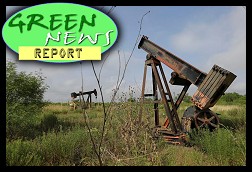 'Green News Report' 4/1/25
'Green News Report' 4/1/25
 Dems Step Up: Crawford Landslide in WI; Booker Makes History in U.S. Senate: 'BradCast' 4/2/25
Dems Step Up: Crawford Landslide in WI; Booker Makes History in U.S. Senate: 'BradCast' 4/2/25 Judge Dismisses Long-Running Challenge to GA's Unverifiable, Insecure E-Vote System: 'BradCast' 4/1/25
Judge Dismisses Long-Running Challenge to GA's Unverifiable, Insecure E-Vote System: 'BradCast' 4/1/25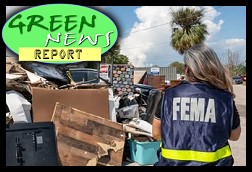 'Green News Report' 4/1/25
'Green News Report' 4/1/25 Bad Court and Election News for Trump is Good News for America: 'BradCast' 3/31/25
Bad Court and Election News for Trump is Good News for America: 'BradCast' 3/31/25 Sunday 'Great Start!' Toons
Sunday 'Great Start!' Toons Vets Push Back at Trump, Musk Plan to Slash Health Care, 80K V.A. Jobs: 'BradCast' 3/27/25
Vets Push Back at Trump, Musk Plan to Slash Health Care, 80K V.A. Jobs: 'BradCast' 3/27/25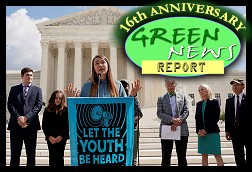 'Green News Report' 3/27/25
'Green News Report' 3/27/25 Signal Scandal Worsens for Trump, GOP; Big Dem Election Wins in PA: 'BradCast' 3/26
Signal Scandal Worsens for Trump, GOP; Big Dem Election Wins in PA: 'BradCast' 3/26 'Emptywheel' on Why Trump NatSec Team Should 'Resign in Disgrace' After Signal Chat Debacle: 'BradCast' 3/25/25
'Emptywheel' on Why Trump NatSec Team Should 'Resign in Disgrace' After Signal Chat Debacle: 'BradCast' 3/25/25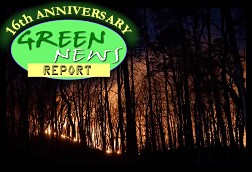 'Green News Report' 3/25/25
'Green News Report' 3/25/25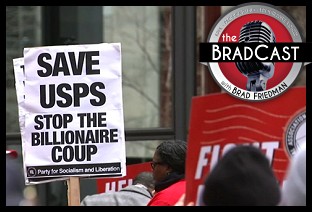 USPS 'Belongs to the People, Not the Billionaires': 'BradCast' 3/24/25
USPS 'Belongs to the People, Not the Billionaires': 'BradCast' 3/24/25 Sunday 'Suddenly Conceivable' Toons
Sunday 'Suddenly Conceivable' Toons 'Green News Report' 3/20/25
'Green News Report' 3/20/25 We're ALL Voice of America Now: 'BradCast' 3/20/25
We're ALL Voice of America Now: 'BradCast' 3/20/25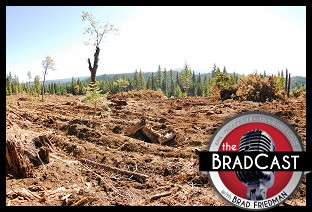 What Trump's 'Timber Production Expansion' Means (and Costs): 'BradCast' 3/19/25
What Trump's 'Timber Production Expansion' Means (and Costs): 'BradCast' 3/19/25 Courts Largely Holding Against Trump, Musk Lawlessness: 'BradCast' 3/18/25
Courts Largely Holding Against Trump, Musk Lawlessness: 'BradCast' 3/18/25 Chief VOA Reporter on Outlet Falling Silent First Time Since 1942: 'BradCast' 3/17/25
Chief VOA Reporter on Outlet Falling Silent First Time Since 1942: 'BradCast' 3/17/25 Trump EPA Unveils Plans to Endanger, Sicken Americans: 'BradCast' 3/13/25
Trump EPA Unveils Plans to Endanger, Sicken Americans: 'BradCast' 3/13/25 Trump Nixed Enforce-ment Against 100 Corp. Lawbreakers: 'BradCast' 3/12/25
Trump Nixed Enforce-ment Against 100 Corp. Lawbreakers: 'BradCast' 3/12/25 Bad Day for 'Strongmen': 'BradCast' 3/11
Bad Day for 'Strongmen': 'BradCast' 3/11 WI Election Could Flip Supreme Court Control, Musk Jumps In: 'BradCast' 3/10
WI Election Could Flip Supreme Court Control, Musk Jumps In: 'BradCast' 3/10
![Click to show/hide [+]](https://bradblog.com/images/toggle_plus.gif)
 VA GOP VOTER REG FRAUDSTER OFF HOOK
VA GOP VOTER REG FRAUDSTER OFF HOOK Criminal GOP Voter Registration Fraud Probe Expanding in VA
Criminal GOP Voter Registration Fraud Probe Expanding in VA DOJ PROBE SOUGHT AFTER VA ARREST
DOJ PROBE SOUGHT AFTER VA ARREST Arrest in VA: GOP Voter Reg Scandal Widens
Arrest in VA: GOP Voter Reg Scandal Widens ALL TOGETHER: ROVE, SPROUL, KOCHS, RNC
ALL TOGETHER: ROVE, SPROUL, KOCHS, RNC LATimes: RNC's 'Fired' Sproul Working for Repubs in 'as Many as 30 States'
LATimes: RNC's 'Fired' Sproul Working for Repubs in 'as Many as 30 States' 'Fired' Sproul Group 'Cloned', Still Working for Republicans in At Least 10 States
'Fired' Sproul Group 'Cloned', Still Working for Republicans in At Least 10 States FINALLY: FOX ON GOP REG FRAUD SCANDAL
FINALLY: FOX ON GOP REG FRAUD SCANDAL COLORADO FOLLOWS FLORIDA WITH GOP CRIMINAL INVESTIGATION
COLORADO FOLLOWS FLORIDA WITH GOP CRIMINAL INVESTIGATION CRIMINAL PROBE LAUNCHED INTO GOP VOTER REGISTRATION FRAUD SCANDAL IN FL
CRIMINAL PROBE LAUNCHED INTO GOP VOTER REGISTRATION FRAUD SCANDAL IN FL Brad Breaks PA Photo ID & GOP Registration Fraud Scandal News on Hartmann TV
Brad Breaks PA Photo ID & GOP Registration Fraud Scandal News on Hartmann TV  CAUGHT ON TAPE: COORDINATED NATIONWIDE GOP VOTER REG SCAM
CAUGHT ON TAPE: COORDINATED NATIONWIDE GOP VOTER REG SCAM CRIMINAL ELECTION FRAUD COMPLAINT FILED AGAINST GOP 'FRAUD' FIRM
CRIMINAL ELECTION FRAUD COMPLAINT FILED AGAINST GOP 'FRAUD' FIRM RICK SCOTT GETS ROLLED IN GOP REGISTRATION FRAUD SCANDAL
RICK SCOTT GETS ROLLED IN GOP REGISTRATION FRAUD SCANDAL VIDEO: Brad Breaks GOP Reg Fraud Scandal on Hartmann TV
VIDEO: Brad Breaks GOP Reg Fraud Scandal on Hartmann TV RNC FIRES NATIONAL VOTER REGISTRATION FIRM FOR FRAUD
RNC FIRES NATIONAL VOTER REGISTRATION FIRM FOR FRAUD EXCLUSIVE: Intvw w/ FL Official Who First Discovered GOP Reg Fraud
EXCLUSIVE: Intvw w/ FL Official Who First Discovered GOP Reg Fraud GOP REGISTRATION FRAUD FOUND IN FL
GOP REGISTRATION FRAUD FOUND IN FL





















